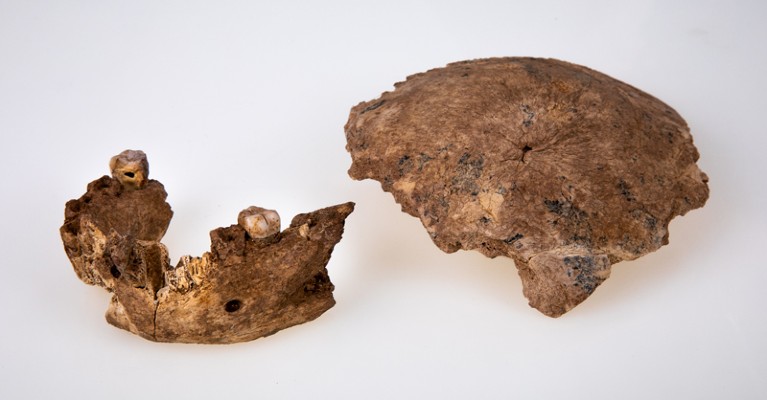Hello Nature readers, would you like to get this Briefing in your inbox free every day? Sign up here.

A mandible and skull found at Nesher Ramla. Researchers suggest these specimens belonged to a previously unknown group of ancient hominins.Credit: Avi Levin and Ilan Theiler, Sackler Faculty of Medicine, Tel Aviv University
Mysterious fossils expand human family
Fossils found in Israel hint that a previously unknown group of hominins — the Nesher Ramla people — were the direct ancestors of Neanderthals. And researchers have suggested that an ancient human skull found in China in the 1930s could belong to a new species, Homo longi (Dragon Man), which might be an even closer relative of modern humans than are Neanderthals. But both findings have sparked debate among scientists. The studies are based on analyses of the size, shape and structure of fossilized bones — methods that are subject to individual judgement and interpretation. As is often the case for fossil finds, there is no DNA evidence.
Reference: Science paper 1, Science paper 2, The Innovation paper 1 & The Innovation paper 2
First video and sounds from Zhurong rover
Nail-biting footage of the Zhurong rover’s descent to the surface of Mars has been released by the China National Space Administration. The video shows a parachute being deployed and released, followed by a view of the ground as the lander hovers while identifying a safe spot to set down. Another video includes an audio recording of the moment Zhurong rolled off its landing platform. The soundtrack might offer scientists the chance to compare audio data with that collected by NASA’s Perseverance rover.
Utrecht ditches impact factor judging
Utrecht University in the Netherlands is formally abandoning the impact factor — a standard measure of scientific success — in all hiring and promotion decisions. By early 2022, the university will judge its scholars by other standards, including their commitment to teamwork and their efforts to promote open science. “Impact factors don’t really reflect the quality of an individual researcher or academic,” says Paul Boselie, a governance researcher and the project leader for the new scheme. “We have a strong belief that something has to change, and abandoning the impact factor is one of those changes.”
DNA records ancient coronavirus epidemic
Researchers examining living people’s genomes have found evidence of a coronavirus epidemic that plagued east Asia some 20,000 to 25,000 years ago. Scientists detected 42 genes in east Asian populations that had rapidly evolved antiviral mutations, suggesting these people had adapted to the emergence of an ancient coronavirus that swept the region and probably lasted for generations.
The New York Times | 6 min read
Reference: Current Biology paper
Features & opinion
Six digital tools for lab management
When it comes to streamlining communications, organizing inventory and general project and laboratory management, group leaders often seek digital tools that go beyond the usual suspects of Google Docs, Zoom, Slack and GitHub. Such tools are especially useful for groups that do not have a full-time lab manager, admin support or a big software budget. Discover six tools group leaders love — many of which have a free option for academic researchers and those at non-profit organizations.
